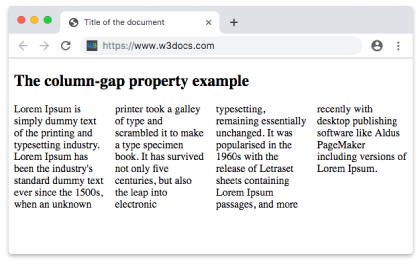The column-gap property sets the length of the gap between columns.
The column-gap property is one of the CSS3 properties.
It is specified by two values: normal and length. "Normal" is a default value. The gap between columns is normal. "Gap" can be specified in em, px and percentages.
Some property extensions are added, such as -webkit- for Safari, Google Chrome, and Opera (newer versions), -moz- for Firefox, -o- for older versions of Opera etc.
When a column-rule is used between columns, it will be in the middle of the gap.
| Initial Value | normal |
| Applies to | Multi-column elements, flex containers, grid containers. |
| Inherited | No. |
| Animatable | Yes. The lenght of the columns gap is animatable. |
| Version | CSS3 |
| DOM Syntax | object.style.columnGap = "100px"; |
Syntax
column-gap: length | normal | initial | inherit;Example of the column-gap property:
<!DOCTYPE html>
<html>
<head>
<title>Title of the document</title>
<style>
div {
-webkit-column-count: 4; /* Chrome, Safari, Opera */
-moz-column-count: 4; /* Firefox */
column-count: 4;
-webkit-column-gap: normal; /* Chrome, Safari, Opera */
-moz-column-gap: normal; /* Firefox */
column-gap: normal;
}
</style>
</head>
<body>
<h2>The column-gap property example</h2>
<div>
Lorem Ipsum is dummy text of the printing and typesetting industry. Lorem Ipsum has been the industry's standard dummy text ever since the 1500s when an unknown printer took a galley of type and scrambled it to make a type specimen book. It has survived not only five centuries, but also the leap into electronic typesetting, remaining essentially unchanged. It was popularised in the 1960s with the release of Letraset sheets containing Lorem Ipsum passages, and more recently with desktop publishing software like Aldus PageMaker including versions of Lorem Ipsum.
</div>
</body>
</html>Result

Example of the column-gap property with the "length" value:
<!DOCTYPE html>
<html>
<head>
<title>Title of the document</title>
<style>
div {
-webkit-column-count: 4; /* Chrome, Safari, Opera */
-moz-column-count: 4; /* Firefox */
column-count: 4;
-webkit-column-gap: 30px; /* Chrome, Safari, Opera */
-moz-column-gap: 30px; /* Firefox */
column-gap: 30px;
}
</style>
</head>
<body>
<h2>Column-gap property example</h2>
<div>
Lorem Ipsum is dummy text of the printing and typesetting industry. Lorem Ipsum has been the industry's standard dummy text ever since the 1500s when an unknown printer took a galley of type and scrambled it to make a type specimen book. It has survived not only five centuries, but also the leap into electronic typesetting, remaining essentially unchanged. It was popularised in the 1960s with the release of Letraset sheets containing Lorem Ipsum passages, and more recently with desktop publishing software like Aldus PageMaker including versions of Lorem Ipsum.
</div>
</body>
</html>Values
| Value | Description | Play it |
|---|---|---|
| normal | The specified length between the columns is normal. 1em value is suggested. This is the default value. | Play it » |
| length | Specifies the length that sets the gap between the column. Can be specified in em, px and percentages. | Play it » |
| initial | Sets the property to its default value. | Play it » |
| inherit | Inherits the property from its parent element. |
Browser support
|
|
|
|
|
|
|---|---|---|---|---|
| ✓ | ✓ | 1.5+ | 3.0+ | 11.1+ |
Practice Your Knowledge
What is the purpose of the column-gap property in CSS?
Correct!
Incorrect!
Quiz Time: Test Your Skills!
Ready to challenge what you've learned? Dive into our interactive quizzes for a deeper understanding and a fun way to reinforce your knowledge.